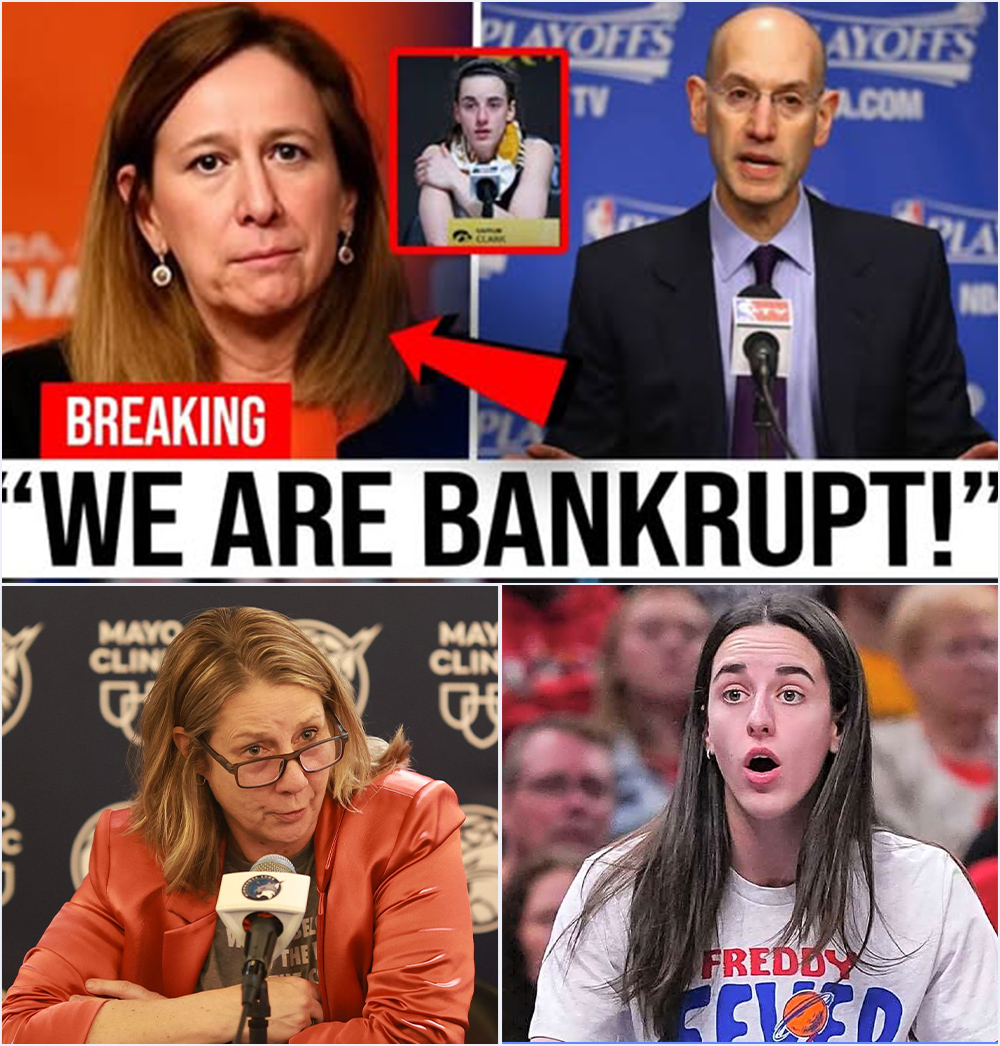
For a few glorious months, the WNBA wasn’t just alive — it was on fire. Headlines that had never before given women’s basketball the time of day were suddenly splashing front pages with three-pointers from the logo. Arenas buzzed with an electricity they hadn’t felt in years. TV audiences soared to unprecedented highs. And at the center of it all was one 22-year-old rookie from Iowa: Caitlin Clark.
She wasn’t just another draft pick. She was a phenomenon. She was the phenomenon — the slender guard whose shooting range, charisma, and swagger dragged an entire league into mainstream conversation. For a moment, it felt like the long-awaited breakthrough. The Clark Effect was real. It looked like a revolution.
And then the revolution collapsed with a groin strain.
When One Player Carries the League
Clark’s injury was the kind of setback athletes have endured for decades. Groin strains heal. But in this case, her absence ripped open the illusion that the WNBA had truly turned a corner.
With Clark sidelined, the dazzling facade fell away. The arenas that had sold out in hours were suddenly half-empty. The national broadcasts that once drew 3.4 million viewers dropped to 200,000. A 94% crash in viewership. Jerseys that once flew off shelves sat unsold. Sponsors began whispering the one thing a fragile league can’t survive: return on investment.
The Clark-era renaissance, it turned out, wasn’t a renaissance at all. It was a house of cards stacked on one rookie’s shoulders. And when she went down, the whole structure came crashing.
A Player Rebellion Brewing
Her absence revealed more than empty seats. It revealed resentment.
Behind the highlight reels and viral clips, players across the league had been simmering. Salaries remain shockingly low — many athletes still drive for Uber in the offseason or live three-to-a-room just to cover rent.
Now, with sponsors and revenue spiking during the Clark boom, the players’ association is demanding a new deal: 50% of basketball-related income, the same model the NBA runs on. The modest pay raises offered by the league? Rejected outright.
Whispers of boycotts and walkouts are no longer whispers. They’re threats echoing in locker rooms, louder with every week Clark stays out.
A Failure of Leadership
Through it all, Commissioner Cathy Engelbert has been mostly silent.
She was quick to claim credit for the “Clark Effect” when things were booming. But now? There is no Plan B. No strategy to retain the millions of new fans who tuned in solely for Clark. The WNBA’s marketing plan wasn’t a plan at all. It was a prayer: Hope Caitlin stays healthy.
The league bet its future on one rookie’s legs. And it lost.
Veterans, who spent years grinding for relevance, now feel erased — invisible in their own league, overshadowed by one rookie and abandoned by the leadership supposed to represent them.
The Officiating Crisis
Clark’s injury didn’t come out of nowhere. All season long, she had been targeted by defenders emboldened by lax officiating. Late hits. Cheap shots. Elbows that would have drawn instant whistles in the NBA.
Instead, refs swallowed whistles, letting play spiral from “physical” into “dangerous.”
It wasn’t just Clark’s problem. It was everyone’s. But when your brightest star — your billion-dollar rookie — is battered without protection, it exposes the entire system. The WNBA hasn’t just struggled with consistency; it has put its athletes at risk.
Coaching Mismanagement
Then there’s the question of how Clark was used.
Coaches rode her hard, pushing minutes, building entire offensive systems around her shoulders. A body already taxed by college mileage was now carrying the weight of a franchise, the league, and an international spotlight.
Her injury wasn’t just bad luck. It was foreseeable. It was the natural endpoint of a league chasing short-term gains and sacrificing the long-term health of the very player it needed most.
The Flower Over the Rot
The most damning truth is this: Caitlin Clark didn’t destroy the WNBA. She exposed it.
She wasn’t the cause of the rot; she was the beautiful flower that briefly grew over a cracked foundation. Her talent, her charm, her charisma brought millions of new eyes. And what those eyes saw beneath the glitter:
Inadequate infrastructure — teams still flying commercial while their NBA counterparts charter private jets.
Subpar facilities — weight rooms and locker rooms that wouldn’t pass muster at elite high schools.
Pressure without support — players expected to be athletes, influencers, and activists all at once with minimal mental health resources.
Leadership out of its depth — executives celebrating hashtags while players ice injuries on folding chairs.
Clark didn’t break the league. She showed the cracks had been there all along.
What Comes Next
The WNBA now stands at a crossroads. Hoping for Clark’s swift return is not a business strategy. It’s desperation.
Her comeback might spike ratings for a week. It might refill arenas. But it will not cure the structural disease:
A financial model that underpays its talent.
A marketing machine that bets on one player at a time instead of building entire rosters of stars.
Leadership unable — or unwilling — to plan beyond the next viral moment.
A system that fails to protect its athletes on the court and off.
Without radical reform — a new CBA, serious investment in facilities and player safety, leadership with a real vision — the WNBA risks sliding back into obscurity, remembered not as a league reborn but as one handed a golden chance and fumbling it into oblivion.
The Great Unraveling
Caitlin Clark’s groin strain wasn’t just an injury. It was a mirror.
It reflected back the truth the league has tried to hide: that beneath the hype and hashtags, the WNBA remains fragile, mismanaged, and dangerously dependent on a single player.
The great unraveling has begun.
Only a courageous reckoning with its failures — and a willingness to finally value and protect all its players — can stop it.
Because without that? The league’s brightest flower may bloom again. But the soil beneath it will remain rotten.
News
Karoline Leavitt vs. Stephen Colbert: The Exchange That Froze a Nation.c3
It began not with a joke, not with a monologue, but with a press conference microphone and a voice that…
Mark Ruffalo Warns Disney: “Cancel Kimmel and Your Stock Will Crash — Don’t Be the Ones That Broke America”
The Hulk has spoken — and this time, his fury isn’t on screen. Mark Ruffalo, Marvel’s longtime Bruce Banner, is…
My Parents Left A Note: “Wedding’s OFF. Expect A Call From My Lawyer.” I Didn’t Argue. 48 Hrs Later…
I’m Jessica Crawford, 28 years old, and three days before my wedding, I found a note from my parents that…
My Parents Paid For My Sister’s College But Not Mine At Graduation, Their Faces Went Pale, When…
I watched my parents’ faces drain of color as I stepped off the stage with my hard-earned MBA. My sister…
Dad Screamed ‘Get Out!’—Next Day I Moved Into My $45M Florida Villa
My name is Abigail Parker and I’m 28 years old. One rainy night, my father screamed, “Get out!” and threw…
Nexstar and Sinclair vs. Disney: Did They Just Overplay Their Hand in the Jimmy Kimmel Fight?
The decision hit Hollywood like a thunderclap: two of the nation’s biggest local TV station owners, Nexstar and Sinclair, moved…
End of content
No more pages to load












